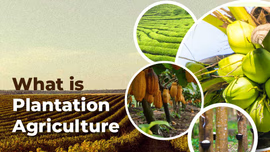Ultimate Guide to Grapes Cultivation in India

Grape cultivation is also called viticulture. The planting season of grapes in India is between November and March across different regions, which is also known as the Grape Season in India. The different grape varieties available in India include Bangalore Blue, Thompson seedless, Anab-e-Shahi, etc. Grape cultivation has significant economic benefits for Indian farmers because of high-value products (raisins & wine) and export potential. Go through the blog to learn about the key steps involved in grape cultivation in detail.
Table of Contents
- Introduction to Grape Farming
- What is the Status of Grape Production in India?
- What are the Major Varieties of Grapes in India?
- How to Grow Grapes: Key Steps
- What are the Challenges for Grape Cultivation?
Introduction to Grape Farming
Grape (Vitis vinifera) belongs to the Vitaceae family and is a commercially important fruit crop in India. Even though it is a temperate crop, it has acclimated to the sub-tropical climate of India. Grapes have three main uses: making wine, dry raisins, and direct consumption. Also, grapes are used to make a host of value-added products, like jelly, grape seed oil, grape seed extracts, wine, vinegar, juice, and jam.
Nashik is referred to as the Grape Capital of India. The grape season in India varies in different regions. The planting is done from February to March in North India and from November to January in the peninsular regions. Grape farming is considered a key agricultural activity in India because of the high demand for grapes and grape-based products. It offers health benefits, provides valuable exports, and supports livelihoods. The benefit-cost ratio of one acre of grape farming will be around 1.81.
What is the Status of Grape Production in India?
India is a leading grape producer, counted among the top 10 worldwide. The total production is more than 1,235 thousand tons with a productivity of 11.10 tons/ha. The major states involved in grape cultivation are Maharashtra, Karnataka, Tamil Nadu, and Mizoram. Over 67 % of total production is contributed by Maharashtra during 2023-24 (2nd Advance Estimate), and thus is the top grape-growing state. Karnataka is the second on the list and with a total share of 28%. Grapes occupy 1,75,930 hectares or 2.5% of the total area under fruit production. Also, India exported around 3,43,982 million tons of fresh grapes with a value of Rs. 3,460.70 crores in 2023-24.
What are the Major Varieties of Grapes in India?
Based on colour and seeds, the different grape varieties are:
|
Type |
Variety |
|
White Seedless |
Thompson Seedless, Perlette, Pusa Seedless, and clones like Manik Chaman and Tas-A-Ganesh |
|
White Seeded |
Anab-e-Shahi and its clone (Dilkhush) |
|
Coloured Seedless |
Sharad Seedless, Beauty Seedless |
|
Coloured Seeded |
Gulabi (Muscat), Bangalore Blue |
How to Grow Grapes: Key Steps
The grape cultivation in India involves various stages. Each of them is discussed below:
Soil & Climate
The cultivation of Grapes requires sandy to clayey and loamy soil with good drainage as well as irrigation facilities. A soil with a pH value of 6.5 to 7.5 is best suited for grape cultivation.
Grapes can successfully grow in a temperature range of 15° C to 40° C. A temperature below 10° C can adversely affect the growth and fruiting of vines. The grape crop bears fruit in a hot and dry climate and undergoes dormancy during severe cold in its natural habitat. During the cropping period, the weather should be clear for around 3 to 4 months for better growth of the grapes.
Land Preparation
Land preparation requires ploughing followed by harrowing. The general practice includes two times ploughing and three times harrowing. However, it depends on the type of land. A land leveller should be used to level the land as per the soil type and gradient.
Planting of Vines
Generally, grapes are propagated with the help of hard wood cuttings. In some cases, it is also done using soft wood cuttings, seed, grafting, layering, and budding. Based on the grape variety and cultivation method, the distance between the vines should be maintained. The vines are planted in pits. Ideally, pits of 3x3x3m should be dug. Then, fill these pits with half-part rotten manure and half-part soil. Also, mix 500g potassium sulphate, 30 g of chloropyriphos (1 kg), etc., well and fill it into the pits. In January, 1-year-old rooted cuttings can be planted in these pits. After planting, the vine needs immediate watering.
Manuring & Fertilizer Application
Grapes need a large amount of nutrients for a good-quality crop. Thus, soil fertility needs to be maintained. Apply 55 t/ha of FYM for manuring. Also, the nutrient requirement of the crop can be supplemented by biofertilizers like neem cake, Effective Microorganism (EM), Phosphate Solubilizing Bacteria (PSB), and Azatobacter. At pre-bearing age, provide 100g of urea and 200g of super phosphate on a monthly basis so that every vine forms adequate branches.
At bearing age, place the fertilizers around the vine in a shallow circular 60-75 cm ring at a depth of 10-15 cm. Another method is to open a shallow trench at a distance of 45-60 cm from the vine on both sides of the row. Apply fertilizers in this trench lengthwise and cover it with soil. The nutrient requirement of Nitrogen, Potassium, Phosphorus, and Magnesium varies with the variety chosen, soil characteristics, and cultural practices.
Training & Pruning of Vines
Training is the practice of redirecting the shape, size, and direction of the grape plant to create a proper shape and provide a strong framework/support so that the plant can tolerate the heavy crop load. Many training systems are followed in India for grape cultivation, such as the bower, kniffin, telephone system, and head system. But the popular ones, which are followed on a large scale, are the bower & telephone (T-trellis) system.
Pruning refers to the process of removing the grape plant’s excessive branches, particularly shoots, to achieve a better and top-quality yield. The pruning practice in India is classified into three categories: single pruning – single cropping, double pruning – single cropping, and double pruning – double cropping.
It becomes crucial to harvest and prune vines at the correct time to enjoy a continuous and good harvest. When the vine is dormant, pruning is done, and it should be finished before the appearance of buds. Usually, January and February are ideal for harvesting and pruning. For pruning, those vine parts are cut off where fruits have grown. Prune weak and immature canes to 1-2 buds for inducing vegetative growth.
|
|
Pruning |
Harvesting |
|
Summer |
December – January |
April – May |
|
Monsoon |
May-June |
August-September |
Irrigation & Fertigation
Water requirement is dependent on several factors, like plant age, growth stage, soil type, growing techniques, environmental conditions, annual precipitation, and evapotranspiration. During a growing season, the total water requirement of a vine is between 500 and 1200 mm. Usually, fewer irrigation sessions are required by winemaking varieties in comparison to table varieties. Between Nov-Dec, irrigation is not needed as the vines are dormant. However, irrigation becomes important after pruning. From flowering until full fruit forms, watering is required at an interval of 7 to 10 days. When fruit ripening starts, ensure watering is stopped to prevent bursting and rotting. After harvesting, there is a need for irrigation. Accurate water needs of vines can be evaluated by precision agriculture using advanced technology. An irrigation session can be set up in a week, utilizing drip irrigation with 50 cm valves.
Spraying in Grapes
A tropical, dry atmosphere is ideal for grapes. They need to be treated every 10-14 days as they are at a high risk of diseases like rots and mildews. Spraying is a highly crucial activity in grape cultivation to prevent a variety of diseases. You can observe infestation signs on leaves and shoots to determine the disease type. Some common diseases that damage grapes include Anthracnose, Downy Mildew, Bacterial Leaf Spot, Powdery Mildew, and Rust.
Also, you can observe big financial losses through pest attacks. They not only reduce yield but also impact fruit quality. Major pests found in grape vineyards are Flea Beetles, Thrips, Scale Insects, Leaf Hoppers, and Mealy Bugs. It can be challenging to choose a spraying machine to prevent pests and diseases from spreading in your vineyard. Select a suitable mist blower based on your requirements, including coverage needed, budget, etc.
Harvesting
Grape crops start fruiting after two years of plantation. Most varieties are ready for harvesting once they change colour near the tip and the berries become sweet. The harvesting time of most grape varieties in India is from March to April. You need to remove the decayed, broken, undersized, and deformed berries a day before picking. Early hours of the day are the best time for harvesting clusters when the temperature is usually below 20° C.
Post Harvesting Management
Once the harvesting is done, the next process is post-harvesting, which includes grading, pre-cooling, and storage.
Grading is done as per the colour and size of the grapes to maintain uniformity. Please note that during grading, the size of the berries is considered, not the shape and size of the bunch.
After grading, the grapes are pre-cooled to reduce the field heat and moisture loss. They are pre-cooled at a temperature under 4.4°C in cold rooms or forced air coolers. This precooling needs to be done within 6 hours of harvesting.
At room temperature, grapes have a shelf life of 1 week. It can be prolonged by using suitable methods for reducing desiccation and decay. High humidity (92-96%) and low temperature (0° C) are ideal storage conditions for grapes.
What are the Challenges for Grape Cultivation?
Here are the major challenges faced by grape cultivation at different stages of farming:
- Grapes are highly sensitive to variations in climatic conditions. It can adversely affect berry ripening, pathogen attack, and modify the pattern and incidence of pest attacks.
- Grapevines are at high risk of damage from a wide range of pests and diseases, which significantly affect grape production.
- It needs effective water management, like drip irrigation, as both too little and too much water can impact yield. Also, grapes do not grow well in waterlogged ground.
- Skilled labourers are required across key phases of grape production. Also, there is a challenge of high crop inputs along with advanced crop protection measures and specialized trellis systems.
Mini tractors are ideal for grape farming because of their compact size, which makes it easy to manoeuvre in narrow vineyard rows. Some popular mini tractors available in India are Mahindra Jivo 245 Vineyard and VST Shakti MT 171 DI Samraat. Also, grape cultivation has become convenient due to the increasing use of farm implements like ploughs and sprayers in India.
The traditional grape farming method involves manual spraying for the spraying of pesticides in vineyards, but in bad weather conditions, the manual spraying becomes slightly difficult. Thus, the introduction of boom sprayers and mist blowers has revolutionized grape farming in India. Follow this guide to ensure a profitable grape farming business in India.
Frequently Asked Questions On Ultimate Guide to Grapes Cultivation in India
1. Which months are best to plant grapes?
Grapes are planted from February to March in North India, November to January in Peninsular India, and December to January in South India.
2. What is the best climate for grape cultivation?
The best climate for grape cultivation is hot and dry conditions with a temperature of 15-40° C.
3. Which soil is suitable for grapes?
The most suitable soil for grape cultivation is sandy to clayey and loamy soil that has good drainage and a pH value of 6.5 - 7.5.


Related Blogs












